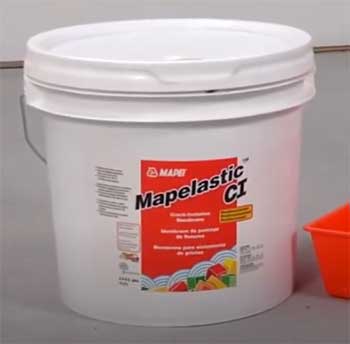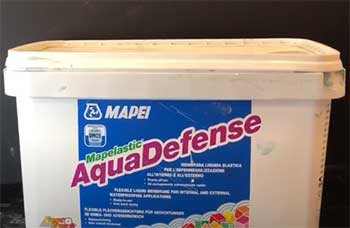Protecting your tiles from water damage and cracks is no joke. That’s where protective membranes like Mapelastic CI and AquaDefense come in.
Both membranes are similar but waterproofing, environmental impact, use cases and ease of application make them different.
No one wants their tiles cracking left and right. That’s why people use protective membranes. Mapelastic series is one of the top options for that.
But which one between CI and AquaDefense should you pick? Here’s a comparison to help you decide.
A Quick Summary of Comparison
| Feature | Mapelastic CI | Mapelastic AquaDefense |
| Waterproofing | No | Yes |
| Environmental impact | More | Less |
| Use cases | Mostly for the interior | Can be used in the exterior |
| Ease of application | Good | Better |
Key Differences Between Mapelastic CI And AquaDefense
As similar as they are, there are still some differences and those are pretty major. Waterproofing, environmental impact, use cases, and ease of application are some of the most noticeable differences between Mapelastic CI and AquaDefense.
Let’s see how both products are different in these departments.
- Waterproofing

The biggest appeal of protective membranes is waterproofing, especially when it comes to bathroom and kitchen tiles.
Mapelastic CI won’t waterproof your tiles but AquaDefense will.
Mapelastic CI is a crack-isolation membrane. That means this membrane mostly focuses on preventing cracks under the tiles.
The membrane separates the tiles and grout from the substrate. This helps the tiles to stay safe from the cracks that pop up in the substrate.
As a crack-isolation membrane (primarily), CI’s waterproofing ability is close to zero. You can’t get away with using this where water will be present.
Mapelastic AquaDefense is much more versatile in this regard. AquaDefense is a multi-purpose membrane that provides both crack isolation and water protection. The main focus for AquaDefense is on waterproofing and rightfully so.
AquaDefense is one of the most popular waterproof membranes. This protective element will separate your tile from the substrate so you don’t get cracks and also protect them from water damage from the substrate’s moisture.
This is why AquaDefense is mostly used in the kitchen, bathroom, and other places where people know moisture will be present. It isn’t a popular practice but you can use AquaDefense in “dry” places too. The same doesn’t go for CI, you can only use that in dry places.
- Environmental Impact
Yup, global warming is real. This is why more people go for environmentally healthier options now, the ones they know will release less heavy particles in the air.
CI and AquaDefense both release the same particles, but CI releases them in a higher amount.
CI membrane emits more heavy particles than AquaDefense in all categories. 1 m2 of CI membrane has a higher (1.93E+00) Global Warming Potential or GWP than AquaDefense (1.64E+00). That’s not just it, CI also has more Ozone Depleting Potential (9.41E-07) compared to AquaDefense’s 7.93E-07.
The pattern is the same for the Acidification Potential (AP) for both membranes with CI having a higher number.
- Use Cases
The waterproofing feature makes AquaDefense more versatile in terms of use cases. You can apply it in more areas than the CI because it will be more compatible.

Mapelastic CI is more of an “indoor” membrane.
Sure, you can apply it in a bunch of different rooms and surfaces but they’ll all have to be inside.
If you apply it on exterior surfaces or in places where you know will be water and moisture around, the membrane might just do more harm than good.
AquaDefense doesn’t have this problem. You can apply it pretty liberally on almost every surface. Shower, kitchen, floor, walls and ceilings, swimming pool, and other submerged areas- you name it and AquaDefense will get to it.
Not just that, AquaDefense is also very much suitable for both residential and industrial areas. CI on the other hand is suitable for residential and industrial floors but that’s about it.
For other applications, it is mostly geared toward residential settings.
According to the instruction manual of Mapei, AquaDefense can be applied on more substrates than CI. So for the use case versatility, AquaDefense easily gets the crown.
- Ease of Application
Both products are pretty easy to work with. You can spread them around with foam rollers with ease. The consistency is also very easy to work with, you won’t have to spend extra time trying to work with something that is too thick.
Both membranes also dry really quickly. It takes 30-50 minutes for them to dry completely. Then you can apply the second coat. The question here is: do you need to apply a second coat or not?
According to the CI manual, you don’t have to apply two coats unless you suspect you left some gap. That’s not the case with AquaDefense. You’ll have to apply two coats (according to the manual) to seal the deal.
That makes AquaDefense slightly harder to work with because of the drying time. You’ll have to wait around 2 hours before you can start the next step of your project which is double the time CI takes.
Which One Should You Choose?
The important factor here is what area and surface you’ll be using the protective membrane on. CI and AquaDefense are suited for different surfaces so the answer will depend on that.
If you’re using the membrane on areas you know will have more moisture than normal, you have to go with AquaDefense.
Places like showers, kitchens, and other exteriors also have to deal with water. Since CI isn’t waterproof, it won’t stand a chance.
If you’re planning on using it indoors, CI is a good choice. You can use AquaDefense too, but most people will suggest using CI for drier places.
Overall, if you want something you can use everywhere, AquaDefense is the best choice.
Frequently Asked Questions (FAQ)
Mapelastic CI is used to prevent cracks on tiles.
That will depend on your personal preference. Both are really good sealants but AquaDefense is easier to work with.
Yes, once the AquaDefense coating is completely dry you can tile over it.
Yes, Mapei instructs to use two coats of AquaDefense for proper results.
Final Verdict
Both Mapelastic CI and AquaDefense are amazing products. No matter how much you argue about Mapelastic CI and AquaDefense comparison, the choice comes down to what surface you’re using it on.
Make sure to read the instruction manual properly before applying the membrane and you’ll be fine.
